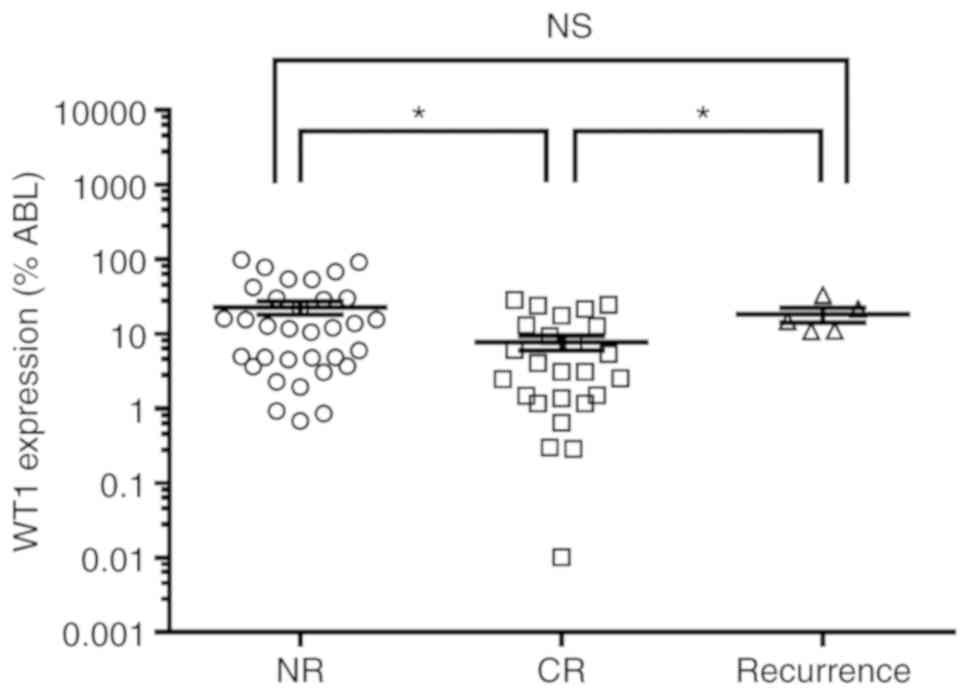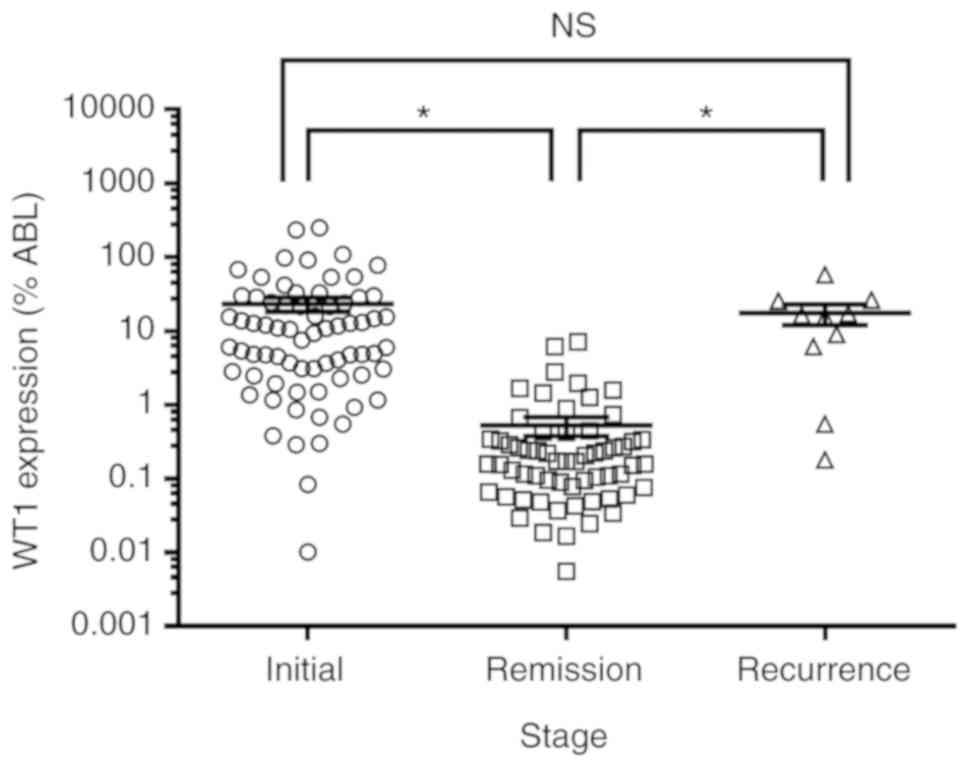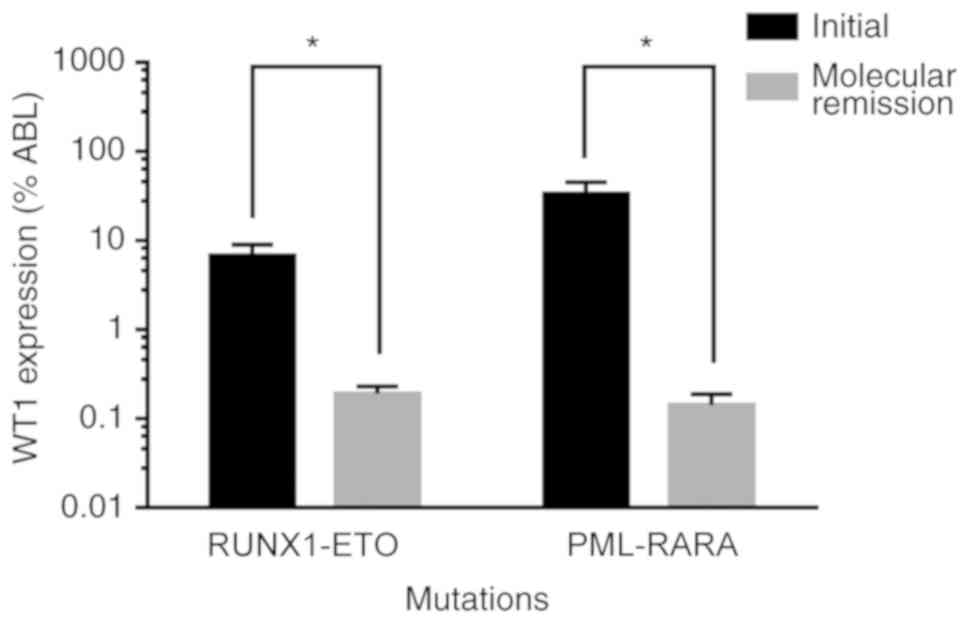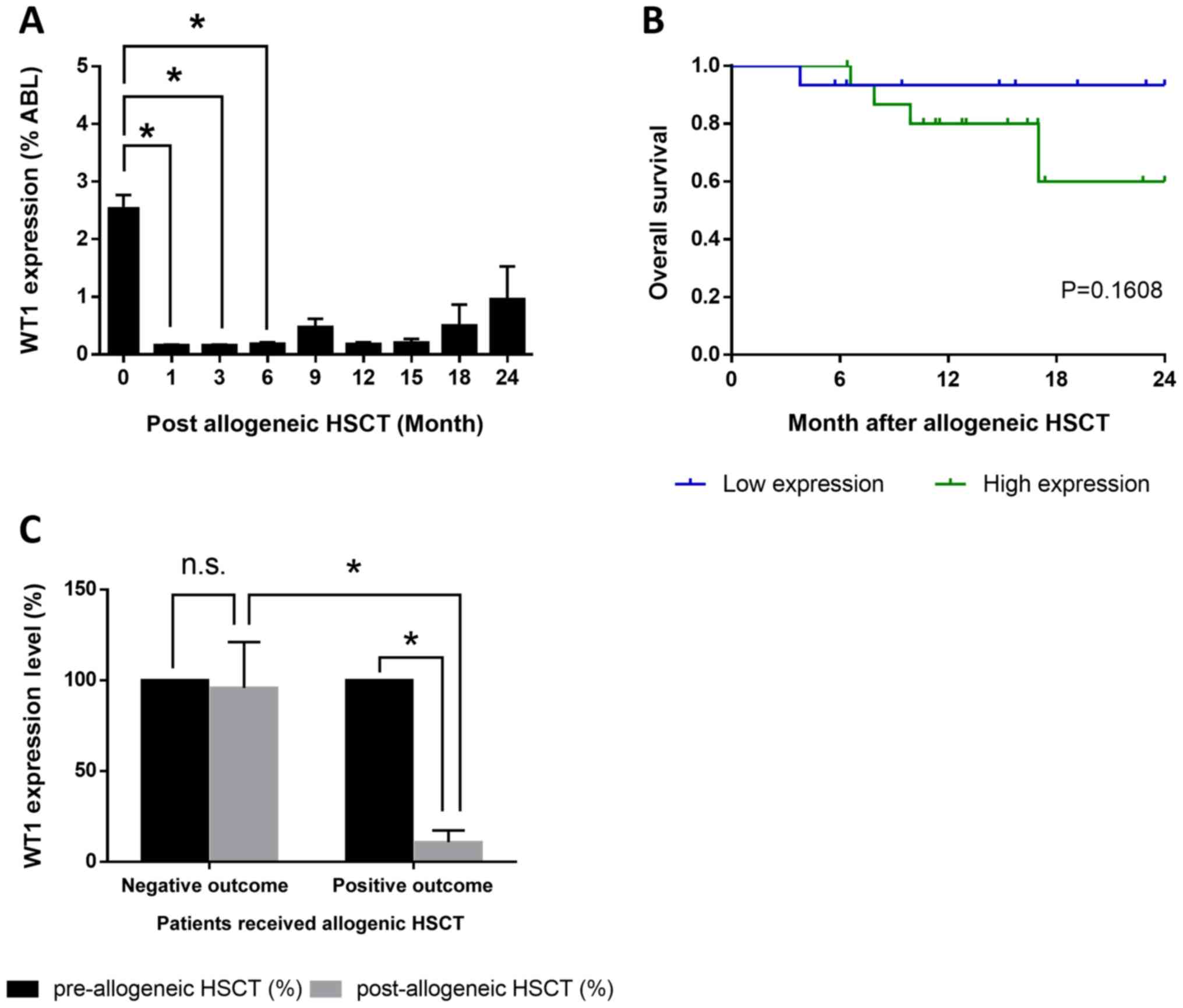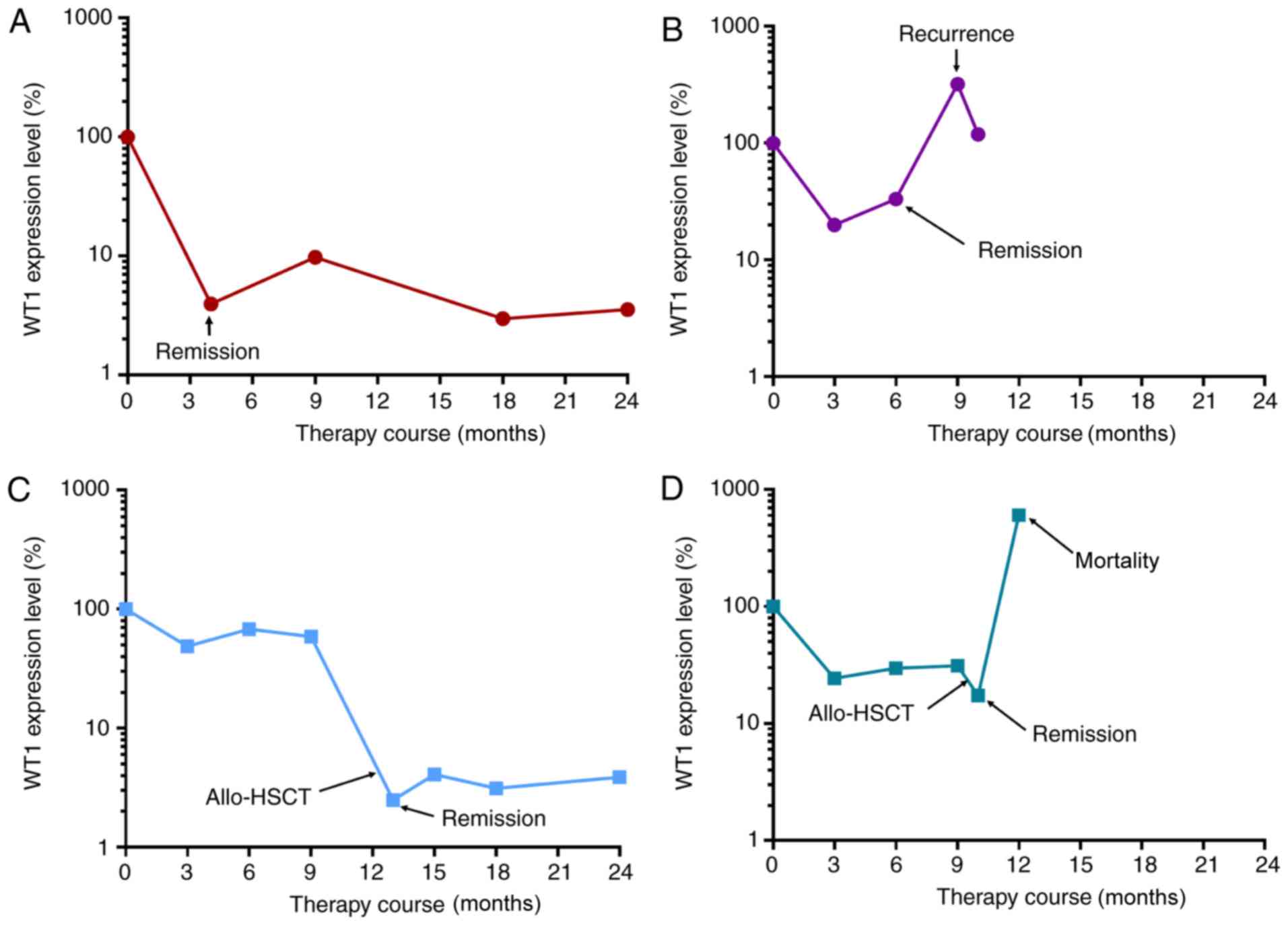|
1
|
Döhner H, Weisdorf DJ and Bloomfield CD:
Acute Myeloid Leukemia. N Engl J Med. 373:1136–1152. 2015.
View Article : Google Scholar : PubMed/NCBI
|
|
2
|
Lagunas-Rangel FA, Chávez-Valencia V,
Gómez-Guijosa MA and Cortes-Penagos C: Acute Myeloid
Leukemia-Genetic Alterations and Their Clinical Prognosis. Int J
Hematol Oncol Stem Cell Res. 11:328–339. 2017.PubMed/NCBI
|
|
3
|
Sun Y, Chen BR and Deshpande A: Epigenetic
Regulators in the Development, Maintenance, and Therapeutic
Targeting of Acute Myeloid Leukemia. Front Oncol. 8:412018.
View Article : Google Scholar : PubMed/NCBI
|
|
4
|
Freireich EJ, Wiernik PH and Steensma DP:
The leukemias: A half-century of discovery. J Clin Oncol.
32:3463–3469. 2014. View Article : Google Scholar : PubMed/NCBI
|
|
5
|
Ommen HB: Monitoring minimal residual
disease in acute myeloid leukaemia: A review of the current
evolving strategies. Ther Adv Hematol. 7:3–16. 2016. View Article : Google Scholar : PubMed/NCBI
|
|
6
|
Hourigan CS, Gale RP, Gormley NJ,
Ossenkoppele GJ and Walter RB: Measurable residual disease testing
in acute myeloid leukaemia. Leukemia. 31:1482–1490. 2017.
View Article : Google Scholar : PubMed/NCBI
|
|
7
|
Zhou Y and Wood BL: Methods of Detection
of Measurable Residual Disease in AML. Curr Hematol Malig Rep.
12:557–567. 2017. View Article : Google Scholar : PubMed/NCBI
|
|
8
|
Elmaagacli AH: Molecular methods used for
detection of minimal residual disease following hematopoietic stem
cell transplantation in myeloid disorders. Methods Mol Biol.
1109:187–207. 2014. View Article : Google Scholar : PubMed/NCBI
|
|
9
|
Tomlinson B and Lazarus HM: Enhancing
acute myeloid leukemia therapy - monitoring response using residual
disease testing as a guide to therapeutic decision-making. Expert
Rev Hematol. 10:563–574. 2017. View Article : Google Scholar : PubMed/NCBI
|
|
10
|
Ross DM, Watkins DB, Hughes TP and
Branford S: Reverse transcription with random pentadecamer primers
improves the detection limit of a quantitative PCR assay for
BCR-ABL transcripts in chronic myeloid leukemia: Implications for
defining sensitivity in minimal residual disease. Clin Chem.
54:1568–1571. 2008. View Article : Google Scholar : PubMed/NCBI
|
|
11
|
Yang L, Han Y, Suarez Saiz F and Minden
MD: A tumor suppressor and oncogene: The WT1 story. Leukemia.
21:868–876. 2007. View Article : Google Scholar : PubMed/NCBI
|
|
12
|
Toska E and Roberts SG: Mechanisms of
transcriptional regulation by WT1 (Wilms' tumour 1). Biochem J.
461:15–32. 2014. View Article : Google Scholar : PubMed/NCBI
|
|
13
|
Morrison AA, Viney RL and Ladomery MR: The
post-transcriptional roles of WT1, a multifunctional zinc-finger
protein. Biochim Biophys Acta. 1785:55–62. 2008.PubMed/NCBI
|
|
14
|
Lyu X, Xin Y, Mi R, Ding J, Wang X, Hu J,
Fan R, Wei X, Song Y and Zhao RY: Overexpression of Wilms tumor 1
gene as a negative prognostic indicator in acute myeloid leukemia.
PLoS One. 9:e924702014. View Article : Google Scholar : PubMed/NCBI
|
|
15
|
Frairia C, Aydin S, Audisio E, Riera L,
Aliberti S, Allione B, Busca A, D'Ardia S, Dellacasa CM, Demurtas
A, et al: Post-remissional and pre-transplant role of minimal
residual disease detected by WT1 in acute myeloid leukemia: A
retrospective cohort study. Leuk Res. 61:10–17. 2017. View Article : Google Scholar : PubMed/NCBI
|
|
16
|
Bergmann L, Miething C, Maurer U, Brieger
J, Karakas T, Weidmann E and Hoelzer D: High levels of Wilms' tumor
gene (wt1) mRNA in acute myeloid leukemias are associated with a
worse long-term outcome. Blood. 90:1217–1225. 1997.PubMed/NCBI
|
|
17
|
Miglino M, Colombo N, Pica G, Grasso R,
Clavio M, Bergamaschi M, Ballerini F, Ghiso A, Ghiggi C,
Mitscheunig L, et al: WT1 overexpression at diagnosis may predict
favorable outcome in patients with de novo non-M3 acute myeloid
leukemia. Leuk Lymphoma. 52:1961–1969. 2011. View Article : Google Scholar : PubMed/NCBI
|
|
18
|
Bennett JM, Catovsky D, Daniel MT,
Flandrin G, Galton DA, Gralnick HR and Sultan C: Proposed revised
criteria for the classification of acute myeloid leukemia. A report
of the French-American-British Cooperative Group. Ann Intern Med.
103:620–625. 1985. View Article : Google Scholar : PubMed/NCBI
|
|
19
|
Vardiman JW, Thiele J, Arber DA, Brunning
RD, Borowitz MJ, Porwit A, Harris NL, Le Beau MM,
Hellström-Lindberg E, Tefferi A, et al: The 2008 revision of the
World Health Organization (WHO) classification of myeloid neoplasms
and acute leukemia: Rationale and important changes. Blood.
114:937–951. 2009. View Article : Google Scholar : PubMed/NCBI
|
|
20
|
Ayatollahi H, Sadeghian MH, Naderi M,
Jafarian AH, Shams SF, Motamedirad N, Sheikhi M, Bahrami A and
Shakeri S: Quantitative assessment of Wilms tumor 1 expression by
real-time quantitative polymerase chain reaction in patients with
acute myeloblastic leukemia. J Res Med Sci. 22:542017. View Article : Google Scholar : PubMed/NCBI
|
|
21
|
Malagola M, Skert C, Ruggeri G, Turra A,
Ribolla R, Cancelli V, Cattina F, Alghisi E, Bernardi S, Perucca S,
et al: Peripheral blood WT1 expression predicts relapse in AML
patients undergoing allogeneic stem cell transplantation. BioMed
Res Int. 2014:1230792014. View Article : Google Scholar : PubMed/NCBI
|
|
22
|
Inoue K, Sugiyama H, Ogawa H, Nakagawa M,
Yamagami T, Miwa H, Kita K, Hiraoka A, Masaoka T, Nasu K, et al:
WT1 as a new prognostic factor and a new marker for the detection
of minimal residual disease in acute leukemia. Blood. 84:3071–3079.
1994.PubMed/NCBI
|
|
23
|
EN 13641:2002, . Elimination or reduction
of risk of infection related to in vitro diagnostic reagents. In
vitro diagnostic medical devices Directive. EU Declaration of
Conformity. 2017.
|
|
24
|
EP9-A2, . Method Comparison and Bias
Estimation Using Patient Samples: Approved Guideline. 22. 2nd.
NCCLS; Wayne, PA: 2002
|
|
25
|
Zhu HH, Jiang H, Jiang B, Lu J, Jiang Q,
Bao L, Zhang XH, Qin YZ and Huang XJ: Cytarabine, aclarubicin and
granulocyte colony-stimulating factor regimen represents an
effective and safe salvage regimen for patients with acute myeloid
leukemia refractory to first course of induction chemotherapy. Leuk
Lymphoma. 54:2452–2457. 2013. View Article : Google Scholar : PubMed/NCBI
|
|
26
|
Gallego Hernanz MP, Torregrosa Diaz JM,
Sorel N, Bobin A, Dindinaud E, Bouyer S, Desmier D, Brizard F,
Leleu X, Maillard N, et al: Long-term molecular remission in a
patient with acute myeloid leukemia harboring a new NUP98-LEDGF
rearrangement. Cancer Med. 8:1765–1770. 2019. View Article : Google Scholar : PubMed/NCBI
|
|
27
|
Li H, Xing C, Zhou B, Ye H, Feng J, Wu J
and Gao S: A regulatory circuitry between miR-193a/miR-600 and WT1
enhances leukemogenesis in acute myeloid leukemia. Exp Hematol.
61:59–68.e5. 2018. View Article : Google Scholar : PubMed/NCBI
|
|
28
|
Válková V, Polák J, Marková M, Vítek A,
Hájková H, Sálek C, Procházka B, Cetkovský P and Trněný M: Minimal
residual disease detectable by quantitative assessment of WT1 gene
before allogeneic stem cell transplantation in patients in first
remission of acute myeloid leukemia has an impact on their future
prognosis. Clin Transplant. 27:E21–E29. 2013. View Article : Google Scholar : PubMed/NCBI
|
|
29
|
Gray JX, McMillen L, Mollee P, Paul S,
Lane S, Bird R, Gill D, Saal R and Marlton P: WT1 expression as a
marker of minimal residual disease predicts outcome in acute
myeloid leukemia when measured post-consolidation. Leuk Res.
36:453–458. 2012. View Article : Google Scholar : PubMed/NCBI
|
|
30
|
Mashima K, Oh I, Ikeda T, Toda Y, Ito S,
Umino K, Minakata D, Nakano H, Morita K, Yamasaki R, et al: Role of
Sequential Monitoring of WT1 Gene Expression in Patients With Acute
Myeloid Leukemia for the Early Detection of Leukemia Relapse. Clin
Lymphoma Myeloma Leuk. 18:e521–e527. 2018. View Article : Google Scholar : PubMed/NCBI
|
|
31
|
Polák J, Hájková H, Maalaufová-Soukupová
J, Marková J, Sálek C, Schwarz J and Haškovec C: Estimation of
molecular upper remission limit for monitoring minimal residual
disease in peripheral blood of acute myeloid leukemia patients by
WT1 expression. Exp Ther Med. 3:129–133. 2012. View Article : Google Scholar : PubMed/NCBI
|
|
32
|
Hao Y, Cheng Y, Wu Q, Zhang A, Jiang X and
Xu X: Combined usage of Wilms' tumor gene quantitative analysis and
multiparameter flow cytometry for minimal residual disease
monitoring of acute myeloid leukemia patients after allogeneic
hematopoietic stem cells transplantation. Exp Ther Med.
15:1403–1409. 2018.PubMed/NCBI
|
|
33
|
Duléry R, Nibourel O, Gauthier J,
Elsermans V, Behal H, Coiteux V, Magro L, Renneville A, Marceau A,
Boyer T, et al: Impact of Wilms' tumor 1 expression on outcome of
patients undergoing allogeneic stem cell transplantation for AML.
Bone Marrow Transplant. 52:539–543. 2017. View Article : Google Scholar : PubMed/NCBI
|
|
34
|
Candoni A, De Marchi F, Zannier ME,
Lazzarotto D, Filì C, Dubbini MV, Rabassi N, Toffoletti E, Lau BW
and Fanin R: High prognostic value of pre-allogeneic stem cell
transplantation minimal residual disease detection by WT1 gene
expression in AML transplanted in cytologic complete remission.
Leuk Res. 63:22–27. 2017. View Article : Google Scholar : PubMed/NCBI
|



